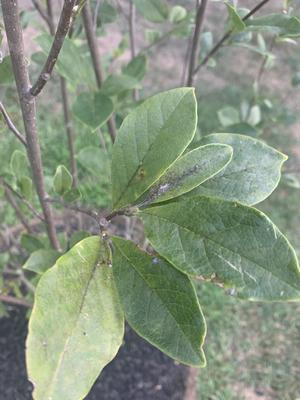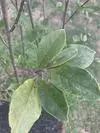
by Gina
(Delaware)





I live in Zone 7, on the east coast. This is a magnolia tree planted just this past spring outside in a very sunny area. It was planted with 50% soil and 50% fertilizer (I think it was called leaf something – the nursery suggested it). I water daily and it was doing fine until recently. There are no other trees close to it. Woods are ~50 feet away. Please see pictures to help me figure out why leaves are turning yellow and have spots, maybe from a fungus. There is new growth (see picture) and even a flower despite the fact that it is now mid-August.
I would love your help to figure out what this is and how to keep my tree from dying. This tree was planted in memory of a dear friend who died in the spring. It’s “Mary’s Tree” and is very special to me. Thank you for any help you can provide. Note: pictures show various levels of what is going on and all taken on the same day.
Comments for Sick Magnolia
Aug 16, 2021
Two or more things…
by: Jacki Cammidge, Certified Horticulturist
This looks like several things going on at once.
In the first picture, I see some chlorosis starting, which is when the veins of the leaves are dark, but the other part starts to lighten up. This is caused by lack of Nitrogen – but don’t go spreading Nitrogen fertilizer around! It could be more of a pH problem, with the Nitrogen in the soil not available to the plant due to low pH (too acidic). To cure this slowly and gently, use Dolomite Lime in small quantities, sprinkled near the base of the tree. This could take a few months to a few seasons to correct, depending on your natural soil and pH levels. Areas with a lot of conifers nearby can take years of steady application of a buffering agent to swing the other way.
The other issue I see is the leaf margins on picture 2. This kind of damage is typical of wind damage, either mechanical (from the leaves hitting other leaves, or a stake). The other alternative explanation is that it’s reacting to the watering regime where it was raised. Typically, this is overhead watering with a sprinkler. There’s nothing you can do about this, except let it grow out of it.
I don’t see any fungal issues.
In the main, the majority of the rest of the leaves look fine. Yellowing leaves just means that it’s getting ready to shed some of them as they’ve reached the end of their useful life, but there are plenty of others ready to take their place.
This is totally normal, and nothing to worry about as long as there are other new leaves emerging.
Keep in mind that even though Magnolias are classed as a broadleaf evergreen in most warmer climates such as yours, they will still lose some leaves periodically, mostly in the late summer and fall, just like deciduous trees.
The fact that it’s flowering out of season is a bit of a heads up. This indicates that it’s stressed. You could remove the flower so all its strength goes into more root growth and leaves. In any case, remove it once it’s finished opening, so it won’t put all it’s energy into producing seed, which is a huge resource burden on a tree.
When watering, make sure you don’t ‘tease’ it. Give it a GOOD soaking, then let it dry out a bit. I prefer to water one day, then give it a drying out period of one to two days, depending on the temperature and whether you have natural rainfall happening. This won’t be forever, just until it’s established and happy. Drip irrigation rules.

